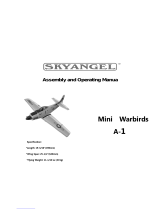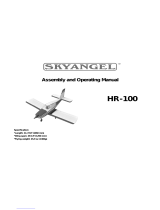
Bauanleitung, Assembly instructions, Notice de montage
Arcus
2
Technische Daten
Spannweite: ca. 1800 mm
Gesamtlänge: ca. 1120 mm
Gesamtflächeninhalt: ca. 32 dm
2
Fluggewicht Segler: ab 560 g
Gesamtflächenbelastung Segler: ab 17,5 g/dm
2
Fluggewicht Motorsegler: ab 700 g
Gesamtflächenbelastung Motorsegler: ab 21,9 g/dm
2
Nicht enthaltenes, jedoch erforderliches Zubehör siehe
Beilageblatt
Werkzeuge und Hilfsmittel siehe robbe Hauptkatalog
Allgemeine Hinweise für den Bauablauf
Verschaffen Sie sich in Verbindung mit den Abbildungen
und den dazugehörigen Kurztexten einen Überblick über
die jeweiligen Bauschritte.
Für Klebearbeiten ausschließlich Sekundenkleber robbe
Speed Typ 2 und zugehörigen Aktivator verwenden.
Richtungsangaben wie z. B. „rechts“ sind in
Flugrichtung zu sehen.
Hinweis zum Motorset:
Mit Hilfe des Motorsets, Bestell
Nr. 3118 kann der Arcus in einen Elektrosegler umgebaut
werden.
Der Einbau der fertig verdrahteten Komponenten ist
sowohl während des Baus als auch nachträglich möglich.
Hinweise zur Fernsteueranlage
Als Fernsteuerung benötigen Sie eine Anlage ab 4
Kanälen und 4 Servos.
Für die Motorseglerversion ist ein elektronischer Regler
mit BEC - Funktion erforderlich (im Motorset enthalten).
Specification
Wingspan: approx. 1800 mm
Length: approx. 1120 mm
Total surface area: approx. 32 dm
2
All-up weight, glider: approx. 560 g
Total surface area loading, glider: approx. 17.5 g/dm
2
All-up weight, motor-glider: approx. 700 g
Total surface area loading,
motor-glider: approx. 21.9 g/dm
2
See separate sheet for accessories not included in the
kit.
See the main robbe catalogue for details of tools and
aids to building.
Sequence of assembly
To gain a clear idea how the model goes together please
study the illustrations and the brief instructions.
Use robbe Speed Type 2 (cyano-acrylate) adhesive and
the associated Activator for all glued joints.
Directions such as “right-hand” are as seen from the tail
of the model looking forward.
Motor set:
the Arcus can be converted into an electric
glider with the help of the motor set, Order No. 3118.
The components in the set are pre-wired, and can be
installed in the model during construction or at any sub-
sequent time.
Radio control system
To fly the model you will need a radio control system with
at least four channels and four servos.
An electronic speed controller with BEC function is
required for the powered glider version; the controller is
included in the motor set.
Caractéristiques techniques
Envergure: approx. 1800 mm
Longueur totale: approx. 1120 mm
Surface alaire totale: approx. 32 dm
2
Poids en ordre de vol, planeur: à partir de 560 g
Charge alaire totale, planeur: à partir de 17,5 g/dm
2
Poids en ordre de vol, motoplaneur: à partir de 700 g
Charge alaire totale, motoplaneur: à partir de 21,9 g/dm
2
Les accessoires indispensables à la mise en œuvre du
modèle, non contenus dans la boîte de construction,
sont présentés sur le feuillet joint.
Outillage et accessoires de montage, cf. catalogue
général robbe
Généralités concernant le déroulement de la construc-
tion
Avant d'entreprendre la construction du modèle, lire les
textes de la notice au regard des illustrations afin de vous
forger une vue d'ensemble des différentes étapes de la
construction.
Pour coller
, utiliser exclusivement la colle cyanoacrylate
robbe Speed Type 2 et l’activateur approprié.
Les indications directionnelles telles que „droite“, par
exemple, sont à considérer dans le sens du vol.
Remarque concernant le kit moteur :
le kit moteur réf.
3118 permet de transformer le modèle Arcus en un moto-
planeur électrique.
Il est possible d’installer les composants entièrement
câblés aussi bien lors de la construction du modèle
qu’ultérieurement.
Consignes concernant l'ensemble de radiocommande
Pour piloter le modèle nous recommandons un ensemble
de radiocommande à partir de 4 voies en liaison avec 4
servos.
Pour la version motoplaneur, il est indispensable d’utiliser
un variateur électronique avec dispositif BEC d’alimenta-
tion directe du récepteur (il fait partie du le kit moteur).
No.
3117





















